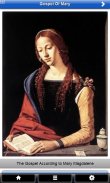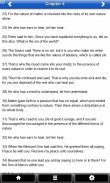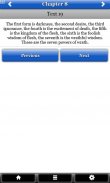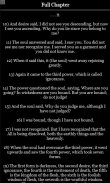







Gospel Of Mary Magdalene FREE

Mô tả của Gospel Of Mary Magdalene FREE
The Gospel of Mary is found in the Berlin Gnostic Codex (or Papyrus Berolinensis 8502, as this ancient collection of Gnostic texts is labeled for archival reasons). This very important and well-preserved codex was apparently discovered in the late-nineteenth century somewhere near Akhmim in upper Egypt. It was purchased in 1896 by a German scholar, Dr. Carl Reinhardt, in Cairo and then taken to Berlin.
The book (or "codex", as these ancient books are called) was probably copied and bound in the late fourth or early fifth century. It contains Coptic translations of three very important early Christian Gnostic texts: the Gospel of Mary, the Apocryphon of John, and the Sophia of Jesus Christ. The texts themselves date to the second century and were originally authored in Greek. (In academic writing over the last century, this codex is variably and confusingly referenced by scholars as the "Berlin Gnostic Codex", the "Akhmim Codex", PB 8502, and BG 8502).
Despite the importance of the discovery of this ancient collection of Gnostic scriptures, several misfortunes including two world wars delayed its publication until 1955. By then the large Nag Hammadi collection of ancient Gnostic writings had also been recovered. It was found that copies of two of the texts in this codex -- the Apocryphon of John, and the Sophia of Jesus Christ -- had also been preserved in the Nag Hammadi collection. The texts from the Berlin Gnostic Codex were used to aid and augment translations of the Apocryphon of John and the Sophia of Jesus Christ as they now are published in Nag Hammadi Library.
But more importantly, the codex preserves the most complete surviving fragment of the Gospel of Mary (as the text is named in the manuscript, though it is clear this named Mary is the person we call Mary of Magdala). Two other small fragments of the Gospel of Mary from separate Greek editions were later unearthed in archaeological excavations at Oxyrhynchus in lower Egypt. (Fragments of the Gospel of Thomas were also found at this ancient site; see the Oxyrhynchus and Gospel of Thomas page for more information about Oxyrhynchus.) Finding three fragments of a text of this antiquity is extremely unusual, and it is thus evidenced that the Gospel of Mary was well distributed in early Christian times and existed in both an original Greek and a Coptic language translation.
Unfortunately the surviving manuscript of the Gospel of Mary is missing pages 1 to 6 and pages 11 to 14 -- pages that included sections of the text up to chapter 4, and portions of chapter 5 to 8. The extant text of the Gospel of Mary, as found in the Berlin Gnostic Codex, is presented below. The manuscript text begins on page 7, in the middle of a passage.
* Fullscreen mode.
* Full version of the Gospel of Mary in English translation.
* Easy and simple to use layout with page animations.
* Choose from a wide variety of customisable themes.
* Small lightweight size.
* Contains advertisements, see non-free version for no ads.
Tin Mừng của Đức Maria được tìm thấy trong Berlin ngộ đạo Codex (hoặc 8502 Berolinensis Papyrus, như bộ sưu tập cổ xưa này của văn bản ngộ đạo được dán nhãn vì lý do lưu trữ). Điều này rất quan trọng và được bảo quản tốt codex dường như được phát hiện vào cuối thế kỷ XIX ở đâu đó gần Akhmim ở Ai-cập. Nó đã được mua vào năm 1896 bởi một học giả người Đức, Tiến sĩ Carl Reinhardt, tại Cairo và sau đó được đưa đến Berlin.
Cuốn sách (hoặc "Codex", như những cuốn sách cổ xưa được gọi là) có thể được sao chép và bị ràng buộc vào cuối thứ tư hoặc đầu thế kỷ thứ năm. Nó chứa các bản dịch Coptic của ba văn bản ngộ đạo Kitô hữu tiên khởi rất quan trọng: Tin Mừng của Đức Maria, Apocryphon của John, và Sophia của Chúa Giêsu Kitô. Các văn bản tự cập nhật từ thế kỷ thứ hai và ban đầu được tác giả trong tiếng Hy Lạp. (Trong văn bản học thuật trong thế kỷ qua, codex này là variably và gây nhầm lẫn với tham chiếu bởi các học giả như "Berlin ngộ đạo Codex", các "Akhmim Codex", PB 8502, và BG 8502).
Mặc dù tầm quan trọng của việc phát hiện ra bộ sưu tập cổ xưa này của kinh ngộ đạo, một số bất hạnh trong đó có hai cuộc chiến tranh thế giới bị trì hoãn công bố cho đến năm 1955. Theo sau đó là Nag Hammadi bộ sưu tập lớn các tác phẩm ngộ đạo cổ đại cũng đã được phục hồi. Có thể thấy rằng các bản sao của hai trong số những văn bản trong Codex này - Apocryphon của John, và Sophia của Chúa Giêsu Kitô - cũng đã được lưu giữ trong các bộ sưu tập Hammadi Nag. Các văn bản từ Berlin ngộ đạo Codex đã được sử dụng để hỗ trợ và làm tăng thêm bản dịch của Apocryphon của John và Sophia của Chúa Giêsu Kitô như họ bây giờ được công bố trong Nag Hammadi Thư viện.
Nhưng quan trọng hơn, codex bảo tồn các mảnh còn sót lại đầy đủ nhất của Tin Mừng của Đức Maria (như các văn bản có tên trong bản thảo, mặc dù rõ ràng này có tên là Mary là người mà chúng ta gọi Đức Maria Magdala). Hai mảnh nhỏ khác của Tin Mừng của Đức Maria từ các phiên bản riêng biệt của Hy Lạp sau đó đã được khai quật trong các cuộc khai quật khảo cổ học tại oxyrhynchus trong thấp hơn Ai Cập. (Những mảnh vỡ của Phúc Âm của Thomas cũng đã được tìm thấy tại địa điểm cổ đại này;. Thấy oxyrhynchus và Phúc Âm của Thomas để có thêm thông tin về oxyrhynchus) Tìm ba mảnh vỡ của một văn bản của thời cổ đại này là cực kỳ bất thường, và do đó nó được chứng minh rằng Tin Mừng của Đức Maria đã được phân bố đều trong thời Kitô hữu tiên khởi và tồn tại trong cả một bản gốc Hy Lạp và một bản dịch ngôn ngữ Coptic.
Thật không may là bản thảo còn sót lại của Tin Mừng của Đức Maria là thiếu các trang 1-6 và trang 11 đến trang 14 - trang bao gồm các phần của văn bản đến chương 4, và các phần của chương 5-8. Các văn bản còn tồn tại của Tin Mừng của Đức Maria, như được tìm thấy trong Berlin ngộ đạo Codex, được trình bày dưới đây. Các văn bản viết tay bắt đầu từ trang 7, ở giữa một đoạn văn.
* Chế độ toàn màn hình.
* Phiên bản đầy đủ của Tin Mừng của Đức Maria trong bản dịch tiếng Anh.
* Dễ dàng và đơn giản để sử dụng bố trí với hình ảnh trang.
* Chọn từ một loạt các chủ đề tùy biến.
* Kích thước nhỏ nhẹ.
* Có quảng cáo, xem phiên bản không tự do không có quảng cáo.

























